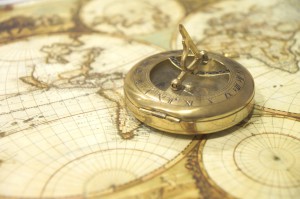We use navigation in almost every aspect of our lives and most of the time don’t give it a second thought. Unless you found this article by chance or good luck, you are probably familiar with navigating your way around the world wide web on a regular basis. We all have experienced navigation on land as well – finding your way through a town or from one place to another. In both cases, we utilize signs, markers or Google to guide us through step by step directions and tell us where we are & where we are going. Before there was Google Maps, people relyed on science to help them navigate their way. From astronomy to geology, science has paved the way for a variety of navigation techniques for thousands of years.
Navigation is the art and science of determining the position of a ship, plane or other type of vehicle, and guiding it to a specific destination. Understanding latitude and longitude is vital in understanding the science of navigation. Latitude is a north-south position which is measured from the Earth’s Equator and longitude is an east-west position measured from the prime meridian. Navigation requires a person to know their relative location, or position compared to other known locations such as the Equator or Prime Meridian.
The earliest navigation methods involved observing landmarks or watching the direction of the sun and stars. Few ancient sailors ventured out into the open sea. Instead, they sailed within sight of land in order to navigate. When that was impossible, ancient sailors watched constellations to mark their position. This method eventually became known as Celestial Navigation. By using the stars, moon, sun and horizon, sailors would calculate their position out in the open ocean.
Today, NASA and other space agencies continue to use celestial navigation for many of their missions outside the Earth’s atmosphere. The astronauts and engineers of the Apollo program used a sophisticated and more modern form of celestial navigation to chart their way to the moon and back. The Mars Exploration Rover also uses celestial navigation to communicate information back to engineers and researchers on Earth.
One of the most familiar navigational tools in the world is the Compass. The compass can be used as a navigational tool on land, at sea, and in the air. Compasses were first used by the Chinese, perhaps as early as 206 BCE and by the 1st Century CE, the compass was the premier navigational tool for explorers around the globe. With little understanding of how the compass needle worked or the science behind it, the compass was thought to be a source of magic or witchcraft. With rumors linking the tool with unearthly powers – some ship captains were forced to hide their compass from view! Modern day science tells us that the compass indicates direction relative to the Earth’s magnetic poles.
In the last century, huge improvements have been made in the accuracy and ease by which ships are navigated with methods such as long range navigation, radar, the gyroscopic compass and the global positioning system (GPS). In the early 1900’s, networks of radio waves were set up and used to plot & pinpoint a geographical location by receiving signals from at least two stations.
Today, the GPS is the most accurate & dependable form of navigation available and has replaced almost all other forms of navigation. A GPS acts as both a transmitter and receiver by using geostationary satellites hundreds of miles above the Earth’s surface. A signal sent from your device hits one satellite which then sends a signal back to you. The signal hits three satellites and then calculates your accurate position by using the equation: distance = speed x time. The signal of a GPS travels at the speed of light – an incredible 186,411 miles per second! Although these modern navigational tools bear no resemblance to the traditional methods, they use the same principals; an accurate measurement of time, the speed equation and fixings from different locations.
The nautical explorers & inventors of our past have forever changed the way we travel the world. Those ancient navigators’ vague attempts to avoid getting lost have been transformed into a sophisticated & calculated science. With modern GPS, we have the ability to know exactly where we are on the planet at any given moment. With the ever growing science of navigation, will we truly be lost ever again?
A Sailor’s Life For Me: Nautical Lesson Plans & Teacher Resources
Exploration Through the Ages: An Interactive Guide to Navigation
The Art & Science of Navigation

